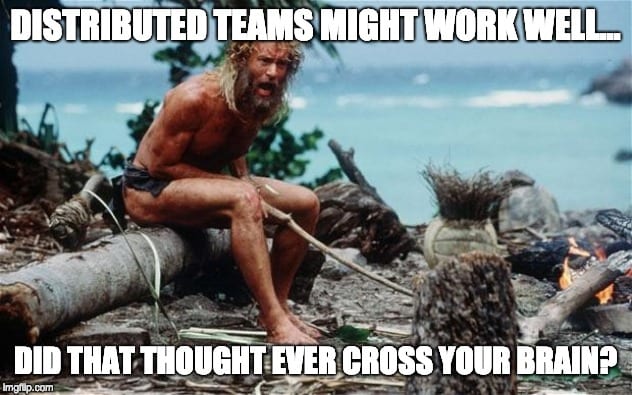
At Simple Thread we have always been a virtual company.
I don’t mean that we employ robots, what I mean is that we are a distributed team.
If there is one thing I’ve learned from having a distributed team, it is that lots of people have had bad experiences with distributed teams! I know this because every time I tell people we have a distributed team they let me know about all of the bad experiences they have had in the past. The usual candidates are team members not being productive, misunderstandings, projects slipping with nobody noticing, etc… all symptoms of information not being disseminated properly.
This all makes sense; it is much harder to communicate with someone who is remote.
Then inevitably they ask me, “Do you have any issues with your distributed team?” I always answer “Absolutely!” Then I go on to explain that my biggest challenge with a distributed team is trying to figure out how to make people really *feel* like a team and then I ask them the question “how do you allow people that rarely see each other to build true relationships?” It’s a hard question to answer, which is probably why their response is usually to ignore the question completely and respond with something along the lines of “But how do you tell if people are doing their jobs?”
And there it is! The real fear everyone has with distributed teams. The fear of those “stay at home slackers”.

Distributed Teams Actually Accelerate Determining Bad Culture Fits
The “stay at home slacker” is the person who only works from home every once in a while, and when they do, they just go home and watch movies. And you know what, for people that don’t work from home very often, they might just do that. It is a rare treat, a day without being under the watchful eye of Big Brother! But the reality is that everyone has work to do (at least everyone at our company does!) and those folks that aren’t pulling their own weight are discovered just as easily on distributed teams as they are in colocated teams. Just because someone in an office is staring at their computer screen, or sitting at their desk, doesn’t mean that they are being productive.
In my experience workers who thrive in distributed environments crave tasks, new challenges, and collaborative work. If they don’t have something to do, they will quickly find something without being told. Zapier coins their very first core value in this way by naming it “default to action.”
Team members who can’t thrive in that sort of an environment are going to struggle, and it can be a challenge to determine this as part of an interview. Past success with working on distributed teams is one of the strongest indicators we have found to determine if someone will fit into this culture. Spending any length of time on a distributed team, especially within a small organization, usually means you focus on getting things done and are an excellent communicator.
Building Distributed Teams Still Takes Work
But that doesn’t mean that distributed teams are all unicorns and rainbows either. Some proponents of distributed teams act like they magically solve all of the problems that software engineers and other creatives have (yes, I called software engineers “creatives”).
Pre-eminent educator and management consultant, Peter Drucker, is credited with the quote “culture eats strategy for breakfast.” Managing a distributed team isn’t an abdication of culture building; but it can be harder because it takes more intentionality.
You have to be more blatant about shaping your culture. Organizing purposeful interactions between team members in order to foster relationships. So even though there can be less incidental interactions to kick off relationships, once those relationships form, they can be just as strong as those in a colocated environment. Creating opportunities for those relationships to form can be a challenge, and I know we aren’t perfect in this area, but we try to bring the team together for regular discussions, learning opportunities, and more traditional team building activities.
Go Forth And Drink Quad Espressos
Again, the primary challenge we face is that it is really hard for people to feel like a team if they rarely see each other. Humans are social animals, and to deny people those face to face interactions does diminish the connections people build. Working from home also reduces the face-to-face interactions that people have overall, and for many people this can be a huge problem.

I highly encourage folks to get out of the house, go to a coworking space, a coffee-shop, etc… on a regular basis. For those folks who want to work outside of their home full-time, we happily pay for the many benefits which have come from the rise of coworking spaces. Even if the people they see on a day-to-day basis at their coffee shop or coworking space aren’t part of the team, it can still help foster in-person interaction that is sometimes lacking in distributed companies.
Even though we try to bring the team together in person as much as possible (and much of our team is located within a short drive of Richmond, VA), we recognize that for some people only interacting with their team in-person once a month is not enough. And that is fine, not everyone fits well into every work environment.
On / Off Switch
Distributed team members have the same problem that all workers do in the information age, turning off work at the end of the day. It follows us around everywhere. For distributed teams, this problem can be amplified since individual’s work and home environments are often intertwined.
For a remote worker, the easiest way to deal with this is to have a separate workspace in your home. An office where you can close the door and get away from everything else. This isn’t always possible though, and when it isn’t, you have to pay careful attention that your work and home life don’t bleed together too much.
One strategy is to set work hours for yourself, and when work hours are over, “leave” work. It doesn’t mean that your hours have to be exactly the same every day (though this can help), it just means that you have a point that is the end of the day where you get up and leave your computer and don’t do more work until the next day. Your brain needs time to recharge and refresh, so jumping back on your computer at 11pm to do “just one more thing” can be detrimental if done routinely.

Disconnecting from communications is also important, and we encourage team members to not check emails or Slack after hours. I know it is hard, and we all do it, but more separation of our work and personal lives is something we all need. If a real emergency happens, we won’t just drop a message in a Slack channel, we will be calling and reaching out to team members in other ways. Finding a way to disseminate critical information without requiring people to listen for every little ping is a problem that every business faces these days. A constant stream of micro-interactions leads to stress and burnout for any team.
Do or Do Not Distribute Teams; There is No Blend
You might at this point be thinking “but he hasn’t brought up communication once!” And there is a good reason for that, it is because I really don’t think that communication on distributed teams is a big deal, or at least not bigger than in an office, but that comes with a few huge caveats.
The first, and most critical, is that we believe the whole team needs to be distributed.
Having part of a team colocated, and part of a team distributed is a recipe for your distributed team members feeling “left out” and uninformed. It is too easy for colocated team members to just turn around and have a conversation, leaving the remote members of the team completely out of the loop. Being a remote team member of a colocated team takes patience and mental toughness to constantly deal with the fact that you feel like an outsider.
In our experience, the second is that good communication needs to be in real-time, or as close to real-time as possible.
By that I mean that everyone needs to be working at the same time. There are a lot of distributed teams that are spread out across the world and make it work, but I’ve witnessed a problem in those structures; people never communicate as clearly as they think they do.
Everything they say is tainted by their personal context, and preconceived ideas they already have in their head. So when two people are communicating, the recipient almost always needs clarification. This works if people aren’t working at the same time, but you’ll end up with a really long and disjointed feedback loop. This has always been a challenge in any kind of collaborative environment, and one that we haven’t magically found a solution to.
Slack Covers a Multitude of Sins?
Now that I brought up working in real-time, you’re probably wondering about remote collaboration in general. Isn’t collaboration really hard with low fidelity communication channels like Slack?
Yes, yes it is.

One way to solve this issue is to use live video chats like Slack calls, Zoom, or Google Hangouts. This works really well, and especially for folks that do most of their work on computers, screen sharing is quite effective. Communication is the most important piece of the puzzle, but by no means the only piece.
However, software engineers have long since used a toolchain that is perfectly suited to distributed teams. Tools like Git, Github, Trello, JIRA, Basecamp, Pivotal Tracker, etc… are all excellent places for tracking and managing what is being done, and by whom. This means that these tools are already perfect for managing work in distributed teams, and many of them specifically designed for this purpose. Layer on top tools like Dropbox/Google Drive, Google Docs, etc… and you have a plethora of seamless ways to distribute workflow visibility and work artifacts.
Meatspace Does Have its Place
Now let me undo everything I just wrote.
Sometimes a good face-to-face chat is really what you need, or you just prefer. Often it is just really nice to discuss something with someone while sitting across the table. This is why we try to bring the team together in-person monthly, or for more far flung team members, at least a few times each year.Also, conferences, and other learning opportunities are wonderful places to bring your team together in-person. It provides a place where team members get to grow their skills, but then after-hours blow off steam and engage in an environment where their personal responsibilities are far away.
Distributed Teams For Some, Colocated Teams For Others
So to sum it up, there are a number of great reasons to have a distributed team, but by far the biggest reason for us is it saves everyone a ton of time and money, is far more flexible, and allows everyone to have their own space to focus and be productive!
Distributed teams are amazing, but they aren’t for everyone. Some people thrive in a distributed environment, and other people struggle, but for those who thrive it can be one of the most rewarding work experiences you’ll ever have.
Although, I have to leave you with a warning: once you work on a distributed team, it might be hard for you to ever go back to an office!
Loved the article? Hated it? Didn’t even read it?
We’d love to hear from you.



I agree with this article wholeheartedly. It can be hard occasionally though, even as someone who likes working from home I do miss the occasional meatspace/facetime, but I live in Oregon and the rest of my team is in New York, so a coffee shop meetup is not really a possibility.